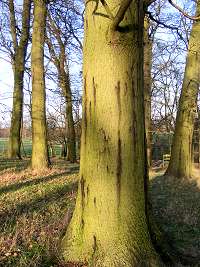| Acute oak decline | |
|---|---|
 Stem bleeding in a tree affected with Acute oak decline | |
| Causal agents | Brenneria goodwinii and Gibsiella quercinecans |
| Hosts | Oaks |
| Distribution | United Kingdom |
Acute oak decline (AOD) is a disease that infects oak trees originally described in the UK. It mainly affects mature oak trees of over 50 years old of both Britain's native oak species: the pedunculate oak ( Quercus robur ) and the sessile oak ( Quercus petraea ). The disease is characterised by the trees bleeding or oozing a dark fluid from small lesions or splits in their bark. [1] Unlike chronic oak decline, acute oak decline can lead to the death of trees within 4 to 5 years of symptoms appearing. The number of trees affected is thought to number in the low thousands, with a higher number of infected trees being found in the Midlands.
